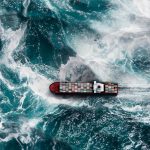Imagine a harbor in a major maritime conflict. A large container ship sits idle because the Liquefied Natural Gas (LNG) fuel it requires is unavailable in the war zone. It is nominally dual-fuel capable, but the diesel system has been inoperative for years. The spare parts and necessary software updates are unavailable because the suppliers are located in a country at war with the United States.
Nearby, methanol-fueled roll-on/roll-off vessels are tied up, victims of cyberattacks on their control systems. An ammonia dual-fueled tanker is closer to sailing. It has a new crew, flown in to replace the crew that perished on the outbound voyage when one of the 2,000-ton ammonia tanks on deck fractured after being struck by a missile fragment.
Decarbonization and digitalization are reshaping the international commercial shipping world in ways that will influence future naval operations. Driven by economic efficiency and regulatory pressures, commercial vessels entering service today are increasingly capable of operating with multiple fuel types and connected to shore by a web of electronic signals. However, the effects of such changes on joint naval/commercial operations have largely escaped the Navy’s scrutiny. Handling toxic clouds formed from ammonia vaporizing and LNG and methanol fires are examples of new skills the Navy must learn. To better plan for this future and mitigate risk, the service must understand the commercial industry’s approach to decarbonization and digitalization.
Decarbonization
Ship owners and designers are planning for new international and governmental carbon regulations for large commercial ships, which can easily last 20 years. Reduced steaming speeds and increased operational efficiency through careful monitoring, maintenance, surface coatings, and energy-saving devices are being achieved. In addition, clean propulsion approaches—rigid sails, Flettner rotors, kites, and so on—are increasingly moving from demonstrations to deployed technology. Even taken together, however, these approaches will be insufficient to power a commercial ship completely. Thus, finding a zero-carbon fuel to power ships has become a central focus of the industry. A single preferable fuel has yet to emerge. Instead, competing fuels are currently battling in the marketplace.
Three alternative fuels—LNG, methanol, and ammonia—are currently the most prominent options. Given their unique requirements, support for each is best designed into the ship at the time of construction.
LNG is already in widespread use as a transitional fuel. It is stored as a liquid at -260° Fahrenheit (F) in specialized tanks; it is highly combustible when vaporized.
Methanol is easier to handle than LNG and is rapidly growing in uptake as a fuel. DNV’s Alternative Fuel Insights reports that more than 200 methanol-capable vessels, including 168 container ships, are on order. Maersk is betting that methanol is the fuel of the future and has ordered a wide range of container vessels with methanol-capable designs.
Ammonia also is growing in popularity as a potential fuel, though it is not currently in use. The first ammonia-capable engines are expected in 2025, and DNV’s Alternative Fuel Insights notes 13 dedicated ammonia-fueled vessels on order, though many more “ammonia ready” ships have been ordered, with the capability to be retrofitted. Ammonia is normally stored at cold—but not cryogenic—temperatures near -30°F, but it also can be stored under pressure at ambient temperature. Ammonia is difficult to burn, so it presents a comparatively low fire or explosion hazard, but any spilled ammonia is highly toxic.
Several other technologies for decarbonization are in development but a good deal further from blue-water applications, including nuclear power—using a new generation of small modular reactors and hydrogen fuel cells.
These may play a larger role in the coming decade, but no large commercial vessels with these fuel sources are currently on order. Between now and 2050, it is likely the commercial fleet will increasingly run on multiple alternative fuels while also sailing at slower speeds.7 All this complicates Navy work alongside commercial vessels, but decarbonization is not the only large change affecting commercial shipping or the Navy’s partnership with it.
Digitalization
Digitalization, or the expanded use of sensors, data, communication, and data analysis for business purposes, is also dramatically transforming commercial shipping. Commercial vessels now bristle with sensors on machinery, hull, and electrical systems, directly interfacing operational technology with onboard hardware. They relay data to shore, where it is processed, and return operational guidance to the vessel. These systems create persistent digital ties from ships to shore-based infrastructure, with significant volumes of data flowing back and forth, including updates of onboard software. In August 2022, marine satellite communication provider Inmarsat reported a 300 percent increase in marine vessel data usage from 2019 to 2022.9
Decarbonization is one of the prime drivers of digitalization. Real-time onshore monitors evaluate the efficiency of the onboard machinery and recommend interventions. Data monitoring also optimizes the vessel’s trim to minimize fuel consumption and schedules in-water hull and propeller cleanings. Decarbonization regulations require accurate fuel consumption documentation and vessel position data. Major marine classification societies are developing digitalization-dependent systems—such as DNV’s Emissions Connect or ABS’s WaveSight platform—to take noon reports from vessels and compute the relevant emissions metrics.
Data is helping to identify emergent problems with equipment and increase operational reliability. Original equipment manufacturers are eager to offer such services, which represent an added value that cannot easily be reverse engineered and establishes a lucrative continuing relationship with ship owners. Vendors also update control software for onboard machinery; the authors are aware of at least one incident when a significant piece of auxiliary machinery on a U.S.-flagged Military Sealift Command vessel could not perform its mission until sufficient bandwidth could be established to download a required software update. In addition, vessel owners may not have control over these operational technology networks, which are run by the manufacturers of the equipment installed on board.
Military Implications
Automation means ships increasingly depend on constant communication with shore infrastructure. Products such as MAN Energy’s PrimeServ Assist, CAT service agreements, and Wärtsilä Expert Insight offer combined machine-learning-based backends that alert manufacturer engineering support staff to investigate anomalies. These shore-based experts then coordinate their responses with the ship’s crew.
While decarbonization and digitalization are major transitions that shipping companies must address for commercial viability, they also will affect U.S. naval operations in conjunction with commercial shipping. As the industry decarbonizes, commercial vessels may need to provide multiple types of fuels for Navy vessels or limit the ships chosen to participate based on their fuel type. Vessels may generally operate at slower speeds, increasing their exposure to danger in conflicts.
In addition, the green fuels under consideration present unique challenges. Each requires significantly more storage volume than diesel oil for equivalent energy, increasing the number of vessels needed to move the same amount of fuel and supplies. Green fuels also tend to have different hazards than diesel oil; many are lower-flashpoint fuels more prone to combustion or explosion. None of the current commercial regulations around the safe storage of these fuels consider protection against the effects of naval weaponry. Thus, new training and procedures for bunkering, damage control, and salvage will become necessary.
Digitalization also brings challenges, as much of the infrastructure depends on daily or even more frequent communication with the vessel. Of concern for cybersecurity is that while sensor systems are distinct from the business-system digital network—which handles cargo booking, crew human resources, and related tasks, both types of traffic may use the same shipboard physical network.
In addition, vessels sailing under emission control would lose off-ship connections. And if key components of data infrastructure are in nations at war with each other or in neutral nations where pressure is brought to cut connections, the shoreside component of this infrastructure could collapse. The globalized footprint of the industry—in which a single vessel commonly has a classification society, equipment manufacturers, a build shipyard, and a flag state spanning multiple countries—makes such shoreside problems more likely. A manufacturer intentionally targeting its own components is not widely considered in commercial cybersecurity, but state coercion of manufacturers could result in malicious updates from trusted sources. In the short term, the loss of these digitalization capabilities is unlikely to cause a large problem in operating commercial vessels. However, in a conflict that lasts many months, the loss of condition-based maintenance, performance optimization, spare part logistics, and myriad other functions moved ashore would harm vessel availability and reliability.
The U.S. government’s increased cybersecurity concerns have resulted in strict rules for handling controlled unclassified information (CUI) that are provided in NIST 800-171: “Protecting Controlled Unclassified Information in Nonfederal Systems and Organizations.”12 Department of Defense contracts now explicitly state the need for CUI compliance for contractors. However, commercial maritime cybersecurity requirements are not nearly as stringent, though the International Maritime Organization has been tightening them with its “Guidelines on Maritime Cyber Risk Management.”9 CUI compliance strategies are still maturing in the domestic U.S. industry, particularly for small businesses. How the U.S. government will coordinate with nontraditional and foreign vendors supporting equipment on commercial sealift vessels with effective cybersecurity measures will require forethought. An additional factor is export control compliance. For example, the simple act of sending an email with shipping requirements to support contract proposal development by a foreign partner may violate CUI and export restrictions.
Longer-term changes driven by decarbonization and digitalization that might influence naval operations are also worth examining. Given the emergence of “dark fleet” vessels moving sanctioned oil outside of the Western financial, insurance, and technical oversight structures, it is likely some vessels will not comply with decarbonization regulations. Adversaries could wind up with a large pool of conventionally powered vessels not available to the U.S. Navy. The same is true of ships from nations that choose not to trade with the European Union.
Digitalization and decarbonization can provide peacetime efficiencies to vessel owners. But they create new vulnerabilities. As Navy leaders contemplate future conflict operations involving commercial vessels, it is essential they consider how decarbonization and digitalization will affect such operations ahead of time.
Source: U.S. Naval Institute






